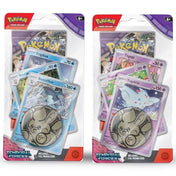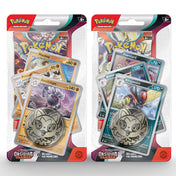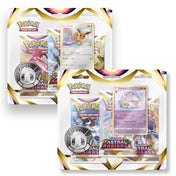The trading card game genre is huge, with games like Magic: The Gathering or the Digimon TCG vying for your attention. However, one of the biggest names in this space is Pokemon. Billions of cards have been sold in the last 25 years, and people collect, trade, and play most notably the Pokemon trading card game in droves.
But what is the Pokemon TCG and what do you need to start creating your own decks and playing the first game in the Pokemon TCG? Here you will find everything you need to know.
What is the Pokemon TCG?
The Pokemon TCG is a trading card game. This means that you collect cards from booster packs and other products and combine them into a deck with which you compete against an opponent. Trading card games are infinitely customizable - literally, since there are more possible decks in Pokemon than there are atoms in the universe - and offer many different strategies to explore and cards to discover.
TCGs like Pokemon divide the game into expansions. These come out several times a year - much like DLCs in video games - and contain brand new maps to keep the game fresh and balanced. For example, the latest sets for Pokemon were Silver Storm Winds , Lost Origin , Astral Glory , and Shining Stars , all of which introduced new or advanced mechanics that make up large parts of the current "metagame" (the best, most competitive strategies).
Specifically, the Pokemon TCG is a two-person game where you and your opponent battle each other with Pokemon, with victory falling to whoever can combine Pokemon, Energy, and Trainer cards to eliminate enough opposing Pokemon. It's a game that involves strategy, resource management, and even elements of mind games as you try to trick your opponents into giving you an advantage.
The Pokemon TCG differs from many other TCGs in that it also contains a much greater element of chance than games like Magic: The Gathering or Yu-Gi-Oh!. Not only do you have to draw the right cards in your deck, many of them also have attacks based on coin tossing or searching the top cards of your deck. This makes Pokemon exceptionally easy to start with, while also presenting great deck-building challenges for those looking for ways to circumvent these elements of randomness.
What you need to get started
To start playing Pokemon cards, you need two things: a deck and a coin to flip.
Your deck is the actual cards you bring to play. Which cards are allowed in your deck depends on the format you're playing. The Standard format is by far the most popular in organized play and only allows cards from recent years (at the time of writing those are those with a "D" or "E" stamped in the lower left corner of the card).
The other two major formats that are played are Expanded, which almost any card since the Black & White expansion can use, and Unlimited, which, as the name suggests, is "everything goes". While Standard dominates in organized play, Unlimited is probably the format you're most likely to be playing at home with your friends.
Building a deck can be a daunting task for newbies, requiring careful balancing of all card types and close attention to the deck's overall strategy. This is one of the aspects that players enjoy the most about the Pokemon TCG. However, if the thought of building your own deck seems intimidating, there are a number of pre-made decks available, such as the recently released V Battle Decks. While these won't be at the highest level of competition, they will offer quick, easy, yet incredibly fun ways to get into the game.
The second important utensil you need is a coin to toss. A lot of things in Pokemon are decided by the toss of a coin, like who goes first or how effective certain attacks are. A regular coin will suffice for casual play, but various Pokemon TCG products - like Booster Blisters or Elite Trainer Boxes - contain specially designed coins that are both good looking and legal for organized play.
There are a few other accessories that, while not necessary, can enhance your gaming experience:
- Sleeves protect your cards and can customize your deck. Elite Trainer Boxes include some of these cases, or you can buy them separately from brands like Ultrapro and Dragon Shield .
- Game mats are soft surfaces on which your cards are placed. Many of them feature beautiful graphics, and some even show the different areas where you must place everything from your deck to your bank and prize cards.
- Deck boxes allow you to transport decks to events more easily. It's always a good idea to have several decks with you when you go playing, and storing them in boxes is safer than simply wrapping a rubber band around them.
How many cards are required to play Pokemon?
Throughout the history of the Pokemon TCG, there are well over 13,000 cards to choose from. However, it is important to have the right cards in your deck.
Your Pokemon TCG deck should contain a total of 60 cards. Unlike some other games, this is a fixed number and you cannot use less than or more than 60 cards. To make things even more difficult, organized play usually only allows one deck to be submitted for an entire tournament, so you need to make sure you're picking the right cards for your strategy.
Pokemon follows what's known as the "rule of four," meaning you can only use four copies of cards with the same name. This rule doesn't apply to basic Energy cards, which you can have any number of. This means that regardless of whether the cards have different functions, you cannot have four cards named "Slaking" or "Kyogre" in your deck . However, if mechanics like V, VMAX, VSTAR, or ex change or add to the name in any way, they don't count as the same card. You could have four cards named "Meowth", four named "Meowth V", four named "Alolan Meowth" and four named "Galarian Meowth" in the same deck... if you were a really big Meowth fan.
Another exception to this rule is Radiant Pokemon, a recent addition to the game. Radiant Pokemon are stronger, shiny forms of classic Pokemon, but you can only have one Radiant Pokemon in your deck, regardless of type. This means you could have a Gardevoir and a Radiant Gardevoir, but not two Radiant Gardevoirs or a Radiant Gardevoir and a Radiant Steelix in the same deck.
Although each deck will have a different ratio of card types to suit its purposes, it's always good to follow the 2:2:1 structure when starting out: two-fifths of your deck should be Pokemon, two-fifths Trainer cards, and one-fifth from energy cards. This means that as a good base you should aim for 24 Pokemon, 24 Trainers, and 12 Energy, and from there you can adjust it to suit your particular needs.
If you are familiar with other TCGs, you may have heard of "sideboards". These are cards that are outside of your deck and can be swapped out between rounds to adjust your strategy. Although sideboards are fairly common in card games, they are not used in the Pokemon TCG.
When you start a game in the Pokemon TCG, the top six cards of your deck are set aside to form your prize cards. When you defeat your opponent's Pokemon, you can pick up one of your prize cards, and whoever takes their last prize card first wins the game.
How to play the Pokemon TCG?
You have your deck, your opponent, and you're ready to sit down and play your first game. What now?
Before either player shuffles their deck or draws cards, a player must flip a coin. If you win the coin toss, you get to decide whether you act first or last. If you lose, your opponent decides. You and your opponent then set aside the top six cards of your deck as prize cards, and then draw another seven cards to form your starting hand.
While other TCGs have different rules to allow you to draw a new opening hand, Pokemon only allows this if you don't have a Basic Pokemon in your hand. You must show your hand to your opponent to confirm you don't have any, then shuffle it back into your deck and draw another seven cards. Both players repeat this process until they have at least one Basic Pokemon in their hand.
The final step in preparation is to place a Basic Pokemon face down on the field as the Active Pokemon. The active Pokemon is the one you attack with, and in turn, it's also the one your opponent can most reliably damage themselves. You may also place up to five other Basic Pokemon face down on your field. This is called your bank and serves as your reserve Pokemon. If your Active Pokemon is Knocked Out and you have no more Benched Pokemon, you immediately lose the game.
Once your hands, active Pokemon, and bank are set up, you and your opponent reveal all of the cards, and the game really begins. The first player begins his turn.
During your turn you can carry out various actions:
- Attach an Energy card to your Active or Benched Pokemon.
- Play a Support Trainer card and any number of other types of Trainer cards. If you have the first turn, you cannot play a supporter card on the first turn.
- Use a Pokemon's ability.
- Evolve a Pokemon by putting the next card in its evolution line on it. For example, you can evolve a Porygon on your bench or as an active Pokemon into Porygon 2 once per turn.
- Retire your Pokemon. Retreating swaps your active Pokemon for one on your Bench, and you must usually discard the specified number of Energy cards attached to it. You can only retreat once per turn.
- Attack. Most attacks require your Pokemon to have a certain number of Energy cards attached, and display a certain amount of damage to the right of their name. If you have the first turn, you cannot attack on the first turn. If you attack, your turn ends immediately after the damage has been calculated.
Note that this is an oversimplified explanation of a single move in the Pokemon TCG. When cards in play change these rules (such as Frosmoth's ability to put Water Energy on any Benched Water-type Pokémon), they take precedence over the general rules.
An important aspect of the Pokemon TCG is type resistances and type weaknesses. At the bottom of each Pokemon card, you'll see a list showing what types it's strong and weak against and to what extent. Weakness shows how much extra damage this Pokemon takes from attacks of the specified type - for example, Staraptor has a x2 weakness to Electric-type attacks and therefore takes double damage. On the other hand, resistance reduces damage taken - Staraptor has a -30 resistance to battle-type attacks, so subtracts 30 from total damage.
Eventually, either your Pokemon or your opponent's will have its HP reduced to zero. At that moment, it becomes incapacitated and goes to its owner's discard pile. Depending on the Pokemon's type, the player who defeated it can take one (for most Pokemon), two, or even three of their own prize cards and put them in their hand. The player who just lost a Pokemon then chooses which Pokemon moves from their Bench to the Active Zone and the next turn begins.
As mentioned earlier, if there are no Pokemon to swap from your bench when your active Pokemon is defeated, you immediately lose the game.
There's still a lot more to learn about the Pokemon TCG. From metas and strategies to combo decks and obscure synergies, this game is all about figuring out what drives your deck and finding ways to build on its strengths. So why not grab some Booster Packs or Collection Boxes and start playing the Pokemon TCG today?



